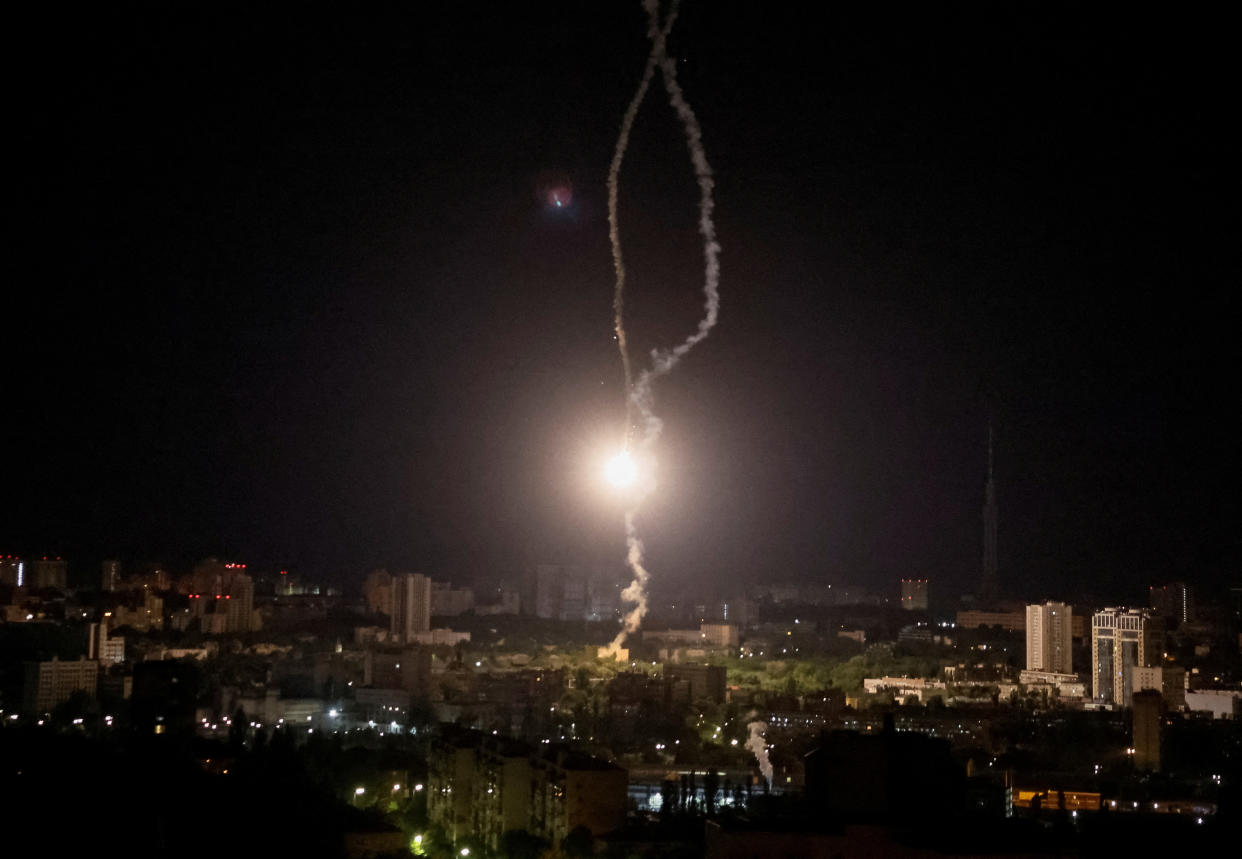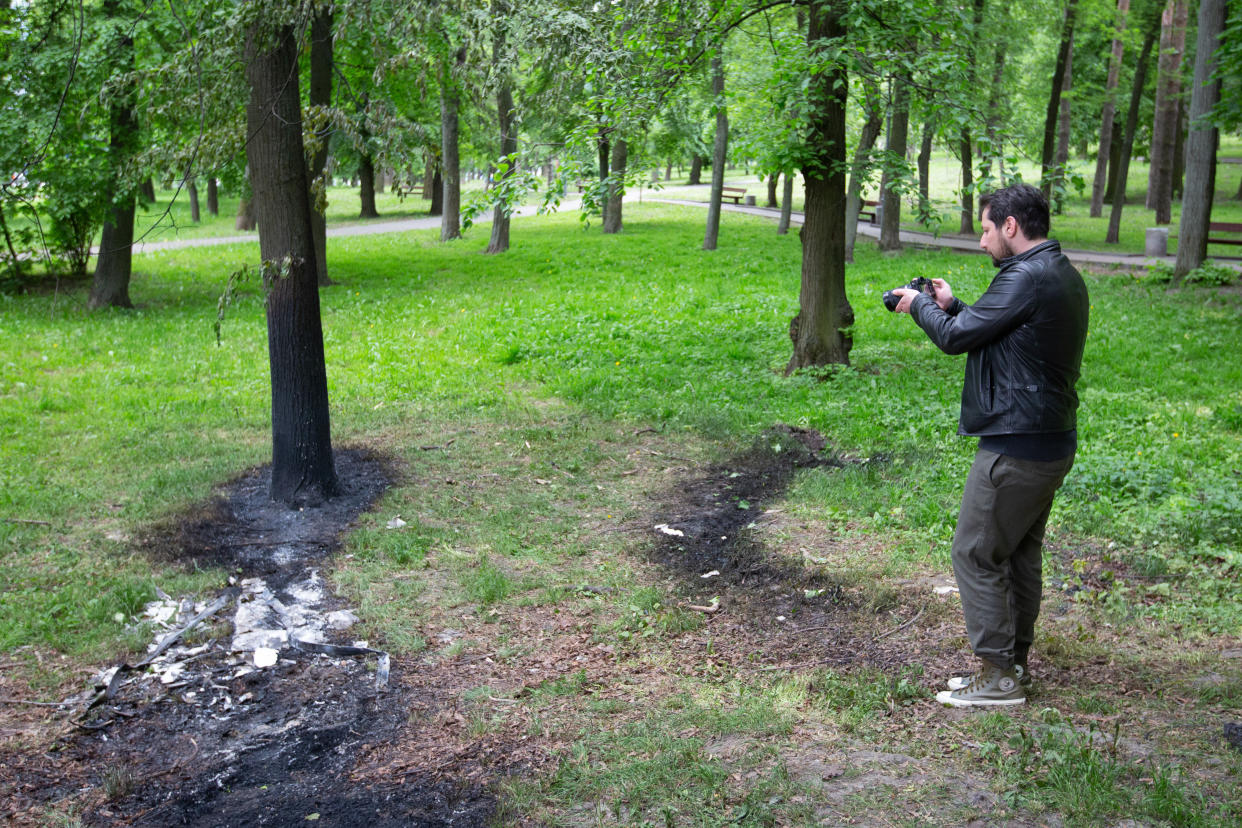Ukraine intercepts all incoming Russian missiles in latest barrage against Kyiv

KYIV — Moscow went 0 for 18.
Russia launched one of the largest bombardments of the Ukrainian capital early Tuesday morning — one of the most sustained volleys of attacks on Kyiv since the start of the full-scale invasion in February 2022. Remarkably, all of the incoming was successfully intercepted by Ukraine’s air defense systems, according to Ukraine’s air force. Those systems, which now include the advanced U.S.-provided Patriot batteries, have been dramatically upgraded by Western partners in the past few months. Six Kinzhal air-launched hypersonic missiles, which Russian President Vladimir Putin once described as “invincible,” were shot down, as were nine Kalibr cruise missiles, three other unknown missiles and six Iranian-made Shahed suicide drones.
Air-raid sirens began sounding at 2:30 a.m. Kyiv time, and soon after, the skies over the city were lit up by the lights of outgoing air defense missiles, and residents began to hear a series of extremely loud explosions. Even for a city that has been repeatedly targeted by Russian missile and drone strikes, the severity and intensity of the explosions last night was above average. One Western ambassador in Kyiv told Yahoo News, “It started with an air alert app siren, which woke me up for a moment. But the real wake-up call came a quarter of an hour later with a series of really loud bangs.”
The Kremlin has frequently touted the “uninterceptable” nature of the Kinzhal, a source of pride for the Russian military. The Kinzhal had indeed been used to significant effect in the first year of Russia’s full-scale war, hitting targets across the country. However, with the insertion of the Patriot air defense system, that’s now changed. On May 4, the first Russian Kinzhal was taken out by a Patriot missile, according to both the Ukrainian government and Pentagon spokesman Pat Ryder.

A senior European diplomat currently based in Kyiv told Yahoo News that after the previous interception of a Kinzhal missile two weeks ago, “Russia just had to try once more. They always do. This time with more missiles and in a more sophisticated manner. The result was the same.”
Kyiv Mayor Vitali Klitschko said that debris from incoming Russian missiles had fallen in many districts in the center of the city, including in the city zoo, starting several fires. The State Emergency Service of Ukraine published images of the damage caused by falling debris, such as a number of civilian buses in flames. When dawn broke, photos of fragments of Russian missiles that had fallen on the streets of Kyiv began circulating on Ukrainian social media.
The Russian government confirmed that it had targeted the Ukrainian capital, and claimed that all the munitions had successfully hit their targets, allegedly destroying an entire Patriot missile battery. The Kremlin’s bold declarations are often dubious: It previously claimed to have destroyed more U.S.-supplied High Mobility Artillery Rocket Systems (HIMARS) than Ukraine has in its arsenal.
There is some ambiguity, however, as to whether or not a Patriot system may have been struck and damaged, possibly by debris from a successful interception.

CNN reported that a “system” was “likely damaged, but not destroyed” in the spate of attacks, citing an unnamed U.S. official. But Patriots consist of many different key structures: launchers, radars, generators, control stations and other components, deliberately spaced apart from one another. If debris fell on a system, the damage to it would depend on exactly what element was affected and whether or not it could be easily repaired or replaced. In Washington, National Security Council spokesperson John Kirby said: “I cannot confirm the reports about the Patriot system being damaged in Ukraine. But if there was damage done that needed to be repaired outside Ukraine, we would certainly assist with that.”
The Russian attacks on Kyiv came just as Ukrainian President Volodymyr Zelensky was embarking on a tour of Europe to meet with the heads of Ukraine’s key European allies and drum up additional military and diplomatic support for his country.
Zelensky had visited Rome, Berlin, Paris and London, receiving significant new pledges of material support on his tour. Of particular significance was the French pledge, announced earlier Tuesday, to send the SCALP, their own version of the U.K.’s long-range Storm Shadow cruise missile, to Ukraine. The Ukrainians have already been using their British-supplied Storm Shadow missiles to hit valuable Russian targets in the occupied city of Luhansk, previously outside the range of their longest munitions. Although not officially confirmed by Kyiv, wreckage recovered at the scene of the missile strikes, and then posted by Russian media, clearly shows components from the British missiles. The U.S. also claims that Ukraine has already fired the cruise missiles at Russian targets.
